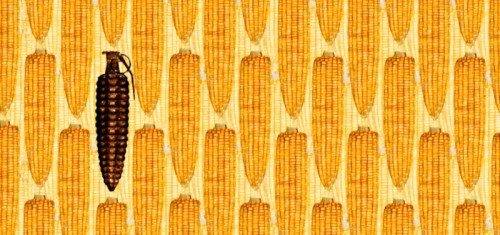There is so much going on in the world these days from the struggling economy, political upheaval in the Middle East to who will replace Charlie Sheen (thank God Ashton Kutcher will have something important on which to focus all those tweets). It is hard to know where to turn first in order to stay mindfully and responsibly informed about the things that truly matter to us all.
Many of us have a tendency to focus on the “news” that is presented each evening before bed or on our portable technological wonders. Many of us, like myself on a number of occasions, believe that our food is just something we can’t worry about today because there are so many other important things that demand our attention. If only I could continue to take the source and composition of my food for granted any longer.
Sigh. Those days are over.
One of those silly little health concerns I often hear about just doesn’t seem to want to get filed away in the “Deal With Some Other Time” box in my consciousness along with microwave ovens, mercury tainted salmon and too much coffee. I have this gnawing fear that I’m going to wake up in twenty years and there will no longer be a dialogue about genetically modified organisms (GMO) because there will not exist anything on our shelves besides GMOs. That freaks me out.
What’s the big deal?
Well, genetic engineering (GE) or genetic modification (GM) of food involves the process of artificially inserting genes into the DNA of food crops or animals themselves, resulting in your basic, every day GMO. Most Americans claim they would not eat GMO’s if they were clearly labeled, however our government keeps voting to keep GMO labeling off of the vast majority of food currently found in our markets. I mean, isn’t there enough writing on our packages, cans and cartons already? Who really needs more words on our food?
I, for one, am literally dying to see more words on my food.
 Since 1996, I have been eating genetically modified ingredients in most of the processed foods I have consumed and there is a strong likelihood that you have joined me. Think about the reality that corn and soy are in thousands of regular products we consume and that the vast majority of the corn and soy used in these products are genetically modified. Unless we are consciously choosing to eat organic ALL the time, there is a likelihood that we order take out, stop at a fast food joint, grab pizza and a beer after work, etc. and just choose to ignore the crucial question of where the ingredients came from.
Since 1996, I have been eating genetically modified ingredients in most of the processed foods I have consumed and there is a strong likelihood that you have joined me. Think about the reality that corn and soy are in thousands of regular products we consume and that the vast majority of the corn and soy used in these products are genetically modified. Unless we are consciously choosing to eat organic ALL the time, there is a likelihood that we order take out, stop at a fast food joint, grab pizza and a beer after work, etc. and just choose to ignore the crucial question of where the ingredients came from.
Just the other day we were ordering Thai food from a local favorite restaurant and my wife called out: “Ask them if they use non-GMO soy in the tofu!” I was too hungry to worry about it and I wanted my Thai fix. I also knew the likely answer and I don’t want to stop eating Thai food. So, unless we really start moving on this issue as a society like Europe where GMO’s are categorically banned, it is unlikely that any of us will be able to live our lives GMO free.
Please consider the food you eat just like the shoes you buy. You wouldn’t wear shoes that didn’t really match your outfit, would you? For me, eating GMO’s doesn’t really match the kind of person I want to be…
Here is a summary of crops, foods and food ingredients that have been genetically modified as of May, 2010 with much deserved credit due to Jeffrey Smith and his amazing website,
Currently Commercialized GM Crops in the U.S.:
(Number in parentheses represents the estimated percentage that is genetically modified.)
Soy(91%) Cotton(71%) Canola(88%) Corn(85%) Sugar Beets(90%) Hawaiian papaya (more than 50%) Alfalfa (at Supreme Court), Zucchini and Yellow Squash (small amount) Tobacco (Quest® brand)
Other Sources of GMOs:
• Dairy products from cows injected with the GM hormone rbGH
• Food additives, enzymes, flavorings, and processing agents, including the sweetener aspartame
(NutraSweet®) and rennet used to make hard cheeses
• Meat, eggs, and dairy products from animals that have eaten GM feed
• Honey and bee pollen that may have GM sources of pollen
• Contamination or pollination caused by GM seeds or pollen
Some of the Ingredients That May Be Genetically Modified: Vegetable oil, vegetable fat and margarines (made with soy, corn, cottonseed, and/or canola)
Ingredients derived from soybeans: Soy flour, soy protein, soy isolates, soy isoflavones, soy lecithin, vegetable proteins, textured vegetable protein (TVP), tofu, tamari, tempeh, and soy protein supplements.
Ingredients derived from corn: Corn flour, corn gluten, corn masa, corn starch, corn syrup, cornmeal, and High-Fructose Corn Syrup (HFCS).
Complete List of Invisible Ingredients
Some of the Foods That May Contain GM Ingredients:
Infant formula
Salad dressing
Bread
Cereal
Hamburgers and hotdogs
Margarine
Mayonnaise
Crackers
Cookies
Chocolate
Candy
Fried food
Chips
Veggie burgers
Meat substitutes
Ice cream
Frozen yogurt
Tofu
Tamari and Soy Sauce
Soy cheese
Tomato sauce
Protein powder
Baking powder
Any sugar not 100% Cane
Confectioner’s glaze
Alcohol
Vanilla (may contain corn syrup)
Peanut butter
Enriched flour
Past
Malt
White vinegar
Non-Food Items That May Contain GM Ingredients:
Cosmetics
Soaps
Detergents
Shampoo
Bubble bath
References:
Natural Agricultural Statistics Service (NASS), Agricultural Statistics Board, US Department of Agriculture: Acreage. (2009)
Ruth Winter , A Consumer’s Dictionary of Food Additives: Descriptions in plain English of more than 12,000 ingredients both harmful and desirable found in foods, 6th ed. (New York: Three Rivers Press, 2004).
Robert S. Igoe , The Dictionary of Food Ingredients, 2nd ed. (New York: Van Nostrand Reinhold, 1989).
Research Triangle Institute, “Economic Characterization of the Dietary Supplement Industry” March 1999.
Codex General Standard for Food Additives (GSFA) Online Database of the World Health Organization(WHO) Food and Agriculture Organization(FAO) of the United Nations and the reports of the Joint FAO/WHO Expert Committee on Food Additives (JECFA). Available at:
The University of Maryland Medical Center database of supplements by name:
Archives of the Agricultural Research Service of the USDA:
Reports of the European Commission Scientific Committee for Food:
U.S. National Institute of Health (NIH) PubMed Central (PMC):




 Jeffrey Sumber is changing the world, one relationship at a time. For over two decades, Jeffrey has worked to understand the human experience from as many angles as possible. As a successful psychotherapist, marriage counselor, and life coach, Jeffrey has worked with thousands of clients who strive to live their best lives.
Jeffrey Sumber is changing the world, one relationship at a time. For over two decades, Jeffrey has worked to understand the human experience from as many angles as possible. As a successful psychotherapist, marriage counselor, and life coach, Jeffrey has worked with thousands of clients who strive to live their best lives.